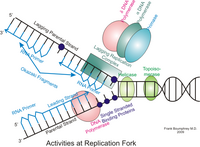
Photo from wikipedia
DNA re-replication leads to genomic instability and has been implicated in the pathology of a variety of human cancers. Eukaryotic DNA replication is tightly controlled to ensure it occurs only… Click to show full abstract
DNA re-replication leads to genomic instability and has been implicated in the pathology of a variety of human cancers. Eukaryotic DNA replication is tightly controlled to ensure it occurs only once during each cell cycle. Geminin is a critical component of this control, it prevents DNA re-replication from occurring during S, G2 and early M phases by preventing MCM helicases from forming pre-replication complexes. Geminin is targeted for degradation by the anaphase promoting complex (APC/C) from anaphase through G1 phase, however, accumulating evidence indicates that Geminin is downregulated in late S phase due to an unknown mechanism. Here, we used a high throughput screen (HTS) to identify microRNAs that can induce excess DNA replication and found that miR-571 could reduce the protein level of Geminin in late S phase independent of the APC/C. Furthermore, miR-571 regulated efficient DNA replication and S phase cell cycle progression. Strikingly, c-Myc suppressed miR-571 expression by binding directly to the miR-571 promoter. At the beginning of S phase, Cdk2 phosphorylated c-Myc at Serine 62, promoting its association with the miR-571 promoter region. Collectively, we identify miR-571 as the first miRNA that prevents aberrant DNA replication, and the Cdk2-c-Myc-miR-571 axis as a new pathway for regulating DNA replication, cell cycle and genomic stability in cancer cells.
Journal Title: Cancer research
Year Published: 2019
Link to full text (if available)
Share on Social Media: Sign Up to like & get
recommendations!